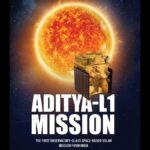Recently, India’s space agency, ISRO, has been making announcements with its groundbreaking missions. Not even two weeks have passed since the historic success of Chandrayaan 3, and ISRO is already gearing up to make history once again. This time, their goals are set on the Sun with the Aditya L1 mission. In this blog post, we will go into the depths of this extraordinary mission and explore how it’s set to change our knowledge of the Sun.
Aditya L1 Mission Overview
Aditya L1 is India’s first mission designed especially to study the Sun. Unlike Chandrayaan’s moon landing, Aditya L1 will not touch down on the Sun’s surface. Instead, it will watch our nearest star from a distance. In fact, during its mission, Aditya L1 will be closer to Earth than the Sun itself. After launch, the spaceship will journey approximately 1.5 million kilometers away from Earth and enter orbit around the Lagrange point L1 in a halo orbit. It will take roughly four months to reach this point, and once it gets, it will remain there for an impressive five-year mission duration, dedicated to studying the Sun. This dual job as a spacecraft and space observatory sets Aditya L1 apart.
Understanding Lagrange Points
Before we dive further into the Aditya L1 mission, let’s discuss the idea of Lagrange points. These are unique places in space where the gravitational pulls of two celestial bodies, in this case, the Sun and Earth, balance out. When we study the Sun-Earth system, there are five Lagrange points, as shown in the diagram below.

These places provide exceptional benefits, including spacecraft stability and constant observation. When a spacecraft is positioned at a Lagrange point, the gravitational pulls of Earth and the Sun cancel out the orbital motion, allowing for stability with minimal effort. This stability is important for conducting long-duration missions. Additionally, a spacecraft put at Lagrange point L1, for example, has an uninterrupted view of both the Earth and the Sun, as they never hide in each other’s shadows. This is in stark contrast to spacecraft in lunar or Earth orbits, which often face times of obscured visibility.
Aditya L1 at Lagrange Point L1
Aditya L1’s mission importance lies in its position at Lagrange point L1. This strategic location, where it gets its name, Aditya L1, has been picked for a reason. Other space agencies that have sent solar telescopes before, such as the Solar and Heliospheric Observatory (SOHO), have also been positioned at L1. The proximity to Earth and the uninterrupted view of the Sun and its activities make L1 and its counterpart, L2, the most important Lagrange points for solar observations.
What Aditya L1 Will Study
To understand what Aditya L1 wants to study about the Sun, let’s first appreciate the sheer magnitude of our star. The Sun’s diameter is a staggering 109 times greater than that of Earth, and it weighs a colossal 333,000 times more than our world. To put it in perspective, you could fit 1.3 million Earths inside the Sun.
Just like the Earth, the Sun comprises different layers, including a core where nuclear fusion reactions produce the energy responsible for sunlight and heat. The core’s temperature can soar up to 15 million degrees Celsius. Beyond the core, there’s the radiation zone, which forms 70% of the Sun’s radius, followed by the convective zone, making up approximately 30% of the radius.
The surface of the Sun, known as the Photosphere, is where we typically observe it from the Earth. Interestingly, the Sun doesn’t possess a solid surface like Earth; instead, it consists of hot clouds and plasma. The Photosphere’s temperature is relatively cooler at 5,500°C. Moving outward, we meet the Chromosphere, where temperatures start to rise again, reaching up to 20,000°C. Above this, there’s the Transition Region, followed by the outermost layer, the Corona, which includes extremely hot plasma at temperatures ranging from 1 to 3 million degrees Celsius.
Unraveling Solar Mysteries
One of the fascinating mysteries of the Sun is the temperature variation across its layers. Why is the core incredibly hot while the surface is comparatively cool, only 5,500°C, and the Corona layer heats up again to millions of degrees Celsius? This question has perplexed scientists for years, and Aditya L1’s journey might help unveil some of these secrets. While scientists have ideas about the temperature differences, the exact reasons remain elusive.
When we observe the Sun from Earth, we mainly see the layer known as the Photosphere. However, during a solar eclipse, we catch a look at the reddish glow surrounding the eclipse, which is the Chromosphere layer. During a complete solar eclipse, the Chromosphere is obscured, and only the Corona layer becomes visible, forming a faint halo around the Sun.
Aditya L1’s Instruments and Objectives
Aditya L1 is equipped with seven sophisticated instruments, often referred to as payloads, to accomplish its mission goals. These devices will study the three uppermost layers of the Sun: the Photosphere, Chromosphere, and Corona. But how will they achieve this from millions of kilometers away?
1. Visible Emission Line Coronagraph (VELC): VELC will focus on studying the Corona layer and watching Coronal Mass Ejections (CMEs).
2. Solar Ultraviolet Imaging Telescope (SUIT): SUIT is tasked with imaging the Sun’s Photosphere and Chromosphere in the ultraviolet range.
3. Solar Low Energy X-ray Spectrometer (SOLEXS): SOLEXS, along with the High Energy L1 Orbiting X-ray Spectrometer (HEL1OS), will study X-rays released by the Sun, especially during solar flares.
4. Aditya Solar Wind Particle Experiment (ASPEX) and Plasma Analyzer Package for Aditya (PAPA): These devices will study the solar wind.
5. Magnetometer (MAG): MAG will measure magnetic fields reaching Lagrange point L1.
Four out of these seven payloads will directly study the Sun, while the remaining three will take measurements in the vicinity of Lagrange point L1.

Aditya L1 in the Context of Solar Missions
Aditya L1 joins a league of missions committed to understanding the Sun. In 2018, NASA launched the Parker Solar Probe in partnership with the European Space Agency. This probe made close contact with the Sun’s Corona layer. Additionally, there’s the Solar Orbiter, a joint mission by NASA and ESA launched in 2020. All these projects share the common goal of enhancing our knowledge of the Sun, particularly its emissions and behaviors.
Key Questions Answered
Now, let’s address the key questions you may have have:
1. When was Aditya-L1 launched?
Aditya-L1’s launch date is an important moment in space history. It was launched with the help of PSLV-XL launch vehicle at 11 :50 IST. It has achieved its intended orbit nearly an hour later, and separated from the 4th stage at 12:57 IST.
https://en.wikipedia.org/wiki/Aditya-L1
2. When will Aditya-L1 land on the Sun?
Aditya-L1 will not land on the Sun but will orbit Lagrange point L1 at a distance from the Sun. It will stay there for an impressive five years, observing the Sun’s actions.
3. Which company is involved in the Aditya-L1 mission?
The Aditya-L1 mission is being supervised by the Indian Space Research Organisation (ISRO), India’s top space agency.
In conclusion, Aditya L1 marks a significant leap in our understanding of the Sun. Positioned strategically at Lagrange point L1, it will start on a five-year mission to unveil the mysteries of our nearest star. With its array of sophisticated instruments, Aditya L1 will capture vital data and insights that can help scientists better understand the Sun’s behavior and emissions. As ISRO continues to make strides in space exploration, the Aditya L1 mission stands as a testament to India’s prowess in scientific study and space technology.





